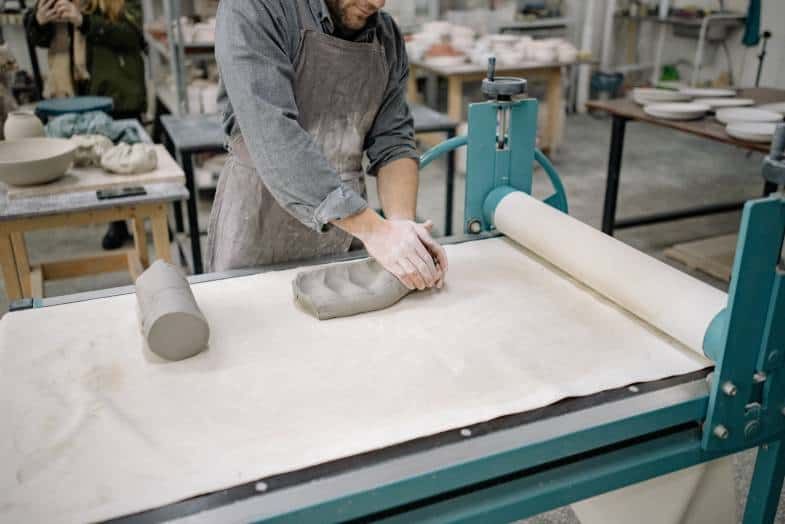What Thickness Should You Roll Your Slabs To?
Concrete slabs are essential structural elements in building construction. They provide a flat, solid surface for floors, roofs, pavements, and foundations. Slabs transfer the weight of the building and its occupants to the supporting ground below.
Proper slab thickness is crucial for structural integrity, durability, and serviceability of slabs. The required thickness depends on several factors like span lengths, imposed loads, soil conditions, and performance requirements.
This article will discuss the recommended slab thicknesses based on various design considerations and provide guidance on selecting an appropriate slab thickness for different building applications.
Recommended Slab Thicknesses
When determining the appropriate thickness for a concrete slab, there are several common recommendations to consider based on the slab’s intended use:
Residential
- Driveways: 4-6 inches (100-150 mm)
- Garage slabs: 4-6 inches (100-150 mm)
- Basement/ground floor slabs: 4 inches (100 mm)
- Sidewalks: 4 inches (100 mm)
- Patios: 4 inches (100 mm)
- Pool decks: 4-5 inches (100-125 mm)
Commercial
- Office buildings: 5 inches (125 mm)
- Retail spaces: 5 inches (125 mm)
- Warehouses: 6 inches (150 mm)
Industrial
- Manufacturing facilities: 6-8 inches (150-200 mm)
- Chemical plants: 6 inches (150 mm)
In general, residential slabs are thinner while commercial and industrial slabs are thicker to withstand heavier loads. However, the appropriate thickness depends on several factors like span, loading, and performance requirements.
Thickness Based on Span
A key factor in determining the required thickness of a concrete slab is its span, which is the distance between its supports. As a general rule, the longer the span, the thicker the slab must be.

This is because a longer span results in greater bending stresses on the slab. Thicker slabs are better able to resist bending and avoid excessive deflections.
Many building codes and design standards provide span to thickness ratios or tables that prescribe the minimum slab thickness for a given span. For example, ACI 318 recommends a span to depth ratio between 20 and 30 for one-way slabs, with lower ratios for two-way slabs.
Other common recommendations include a span to depth ratio of up to 35 for slabs with drop panels or caps and 32 for slabs reinforced with steel fibers. Consulting relevant local standards is advised when determining slab thickness.
In general, minimum slab thicknesses range from 100-150 mm for shorter spans around 2-3 meters, up to 200-300 mm for longer spans of 6 meters or greater. Using adequate thickness for the slab’s span is crucial for controlling deflections.
Thickness Based on Loading
The thickness of a concrete slab is highly dependent on the expected loading conditions. Heavier loads require thicker slabs to prevent cracking or collapse. According to the Engineering Toolbox, typical imposed loads can range from 1.5 kN/m2 in residential buildings up to 10 kN/m2 in commercial or industrial settings.
As a general rule, slabs in domestic buildings should be a minimum of 100-150 mm thick. For light commercial buildings, a thickness of 150-200 mm is recommended. Heavy duty slabs in industrial settings may need to be 300 mm or thicker to withstand heavy concentrated loads from machinery and inventory storage.
When determining the necessary thickness, the maximum allowable deflection and span lengths must also be considered along with the imposed loads. Consulting local building codes is advised. Additionally, a structural engineer can calculate the required thickness based on the specific load characteristics of a project.
Thickness for Crack Control
The thickness of a concrete slab significantly impacts its ability to resist cracking. Thicker slabs are generally more resistant to cracking than thinner ones. This is because thicker slabs have more volume and mass to withstand the inevitable minor movement, shrinkage and stresses that occur as the concrete cures.
As a general rule, the Concrete Network recommends spacing control joints no more than 2-3 times the slab thickness in feet. For example, a 4-inch thick slab should have joints every 8-12 feet. This helps control intermediate cracking between the joints (Source: Controlling Cracks – Slab on Grade Concrete).
The depth of the control joints is also important – they should be cut to a depth of 1/4 the slab thickness to effectively relieve stress. Deeper joints in thicker slabs help prevent cracks from reflecting through the entire depth (Source: Q&A: Preventing Cracks in Concrete Slabs).
In summary, thicker concrete slabs, properly jointed, are more effective at minimizing cracking than thin ones. When designing slab thickness, take into account the spacing and depth of control joints needed to prevent cracks.
Thickness for Fire Resistance
Concrete slabs provide fire resistance by acting as a barrier to heat transfer and flame spread. The International Building Code (IBC) specifies minimum thicknesses for concrete floor and roof slabs to achieve various fire resistance ratings. According to the 2021 IBC Section 722.2.2, “The minimum thicknesses of reinforced and prestressed concrete floor or roof slabs for fire-resistance ratings of 1 hour to 4 hours are shown in Table 722.2.2.1[1].” The table provides the minimum slab thickness in inches for ratings from 1-hour to 4-hours based on the type of aggregate used and whether the concrete is reinforced or prestressed.
For example, a 1-hour fire resistance rating can be achieved with a 3.5″ slab thickness using carbonate or siliceous aggregate, whereas a 4-hour rating requires a minimum 6.2″ thickness with carbonate aggregate. The code also specifies additional details related to concrete cover over reinforcement, type of aggregate used, and prestressing method that impact the required thicknesses. Designers and builders should consult the latest version of the IBC to determine the appropriate concrete slab thickness to meet fire resistance requirements for a building. Selecting an adequate thickness during design and construction is a key factor in achieving the desired fire resistance rating.
Thickness for Sound Control
Increasing the mass of a floor or wall is one of the most effective ways to reduce sound transmission. A common rule of thumb is that doubling the mass increases the sound transmission loss by 5 dB.
For concrete slabs, a thickness of at least 150-200 mm is recommended to provide sufficient airborne sound insulation between rooms (Source).
Acoustic insulation slabs and panels provide mass loaded vinyl noise barriers in various thicknesses like 25 mm, 50 mm, 75 mm and 100 mm. Thicker slabs generally provide more sound insulation. For example, 100mm slabs have an estimated sound reduction of 36 dB, while 25mm slabs reduce sound by 28 dB (Source).
However, the relationship between mass and sound transmission loss is not perfectly linear. Doubling mass does not always double the transmission loss due to other factors like stiffness, damping, and resonant frequency. There are diminishing returns as mass increases. So a number of factors should be considered when selecting slab thickness for optimal sound insulation.
Thickness for Durability
Thicker concrete slabs are generally more durable and stand up better to heavy use and abuse over time. According to this source, the typical thickness for a concrete slab in a residential home is 4 inches, which provides adequate strength and durability for normal use. However, for areas with heavier anticipated traffic or loading, a thicker slab of 5-6 inches or more may be recommended.
Some key factors to consider for slab thickness and durability include:
- The severity of loading – heavier vehicles or equipment require thicker slabs.
- Exposure to weather – exterior slabs or slabs in cold climates may need increased thickness.
- Abrasion resistance – industrial floors or workshops require more durable surfaces.
In summary, thicker slabs are better able to resist damage from heavy repeated loads, temperature changes, moisture penetration, and chemical exposure over the lifetime of the concrete. For most residential settings, 4 inches provides sufficient durability, but commercial and industrial settings may require 6 inches or more depending on the loads and exposure involved.
Thickness for Energy Efficiency
Thicker concrete slabs can help improve the insulating value and energy efficiency of a home. The thickness of the slab impacts its ability to resist heat transfer between the interior and exterior environments. Thicker slabs provide greater thermal mass, which helps moderate indoor temperatures.
For example, the 2018 International Energy Conservation Code (IECC) specifies minimum insulation requirements for slabs based on climate zone. In climate zones 4-8, slabs 12 inches or less below grade require R-10 to R-15 insulation for unheated slabs and R-15 to R-20 for heated slabs depending on the exact climate zone. Thicker slabs with higher insulation values can further reduce heat loss through the slab [1].
Insulating the underside of the slab and extending the insulation past the edges can also improve energy efficiency. Common recommendations are to use 2 inches of extruded polystyrene insulation under the slab and extend it 2 feet past the foundation edges [2]. Thicker slabs allow more insulation to be added underneath.
Conclusions
In summary, when determining slab thickness for your project, consider the following recommendations:
For residential slabs, 4-6 inches is typical. Go with a minimum of 4 inches for light loading conditions. Increase to 5-6 inches for heavier loads, longer spans between supports, or if cracking is a major concern.
For commercial and industrial buildings, a minimum of 5 inches is recommended, with 6 inches or thicker for heavy loads or long spans. Some building codes may dictate minimums.
Always check with local building codes to ensure proper slab thickness. Work with a structural engineer if you have any concerns about deflection or cracking based on your loading conditions and slab design.
Proper slab thickness, reinforcement, joint design, and concrete mix design are all critical for good slab performance. Do not try to save on thickness without consulting with an engineer.
With the right thickness and proper design, you can have a durable, long-lasting concrete slab for your building or project.




